Enzymes & Digestion - Enzyme Action: Reaction Rates (GCSE Biology)
Enzyme Action: Reaction Rates
Investigating Enzyme Action
We can investigate enzyme action including the effect of temperature, pH, enzyme or substate concentration. You can do this by measuring:
- How fast a product is produced
- How fast a substrate is used up
Investigating the Effect of Temperature
We can explore the enzyme catalase which catalyses the reaction that breaks down hydrogen peroxide to water and oxygen gas (which can be measured).
- Set up a water bath at 10 °C.
- Prepare a boiling tube with a set amount of hydrogen peroxide and place this in the water bath.
- Prepare a delivery tube attached to a bung with the delivery tube leading to a measuring cylinder submerged in water.
- Add a sources of catalase to the hydrogen peroxide and immediately attach the bung and start the stopwatch. The oxygen produced will be directly through the delivery tube into the measuring cylinder.
- Measure how much oxygen is produced in 1 minute. Repeat 3 times and calculate the mean amount of oxygen.
- Repeat steps 1-5 but this time with the water bath at varying temperatures of 20 °C, 30 °C, 40 °C and 50 °C.
- Analyse your results. Calculate the rate of reaction at each temperature using your mean oxygen value.
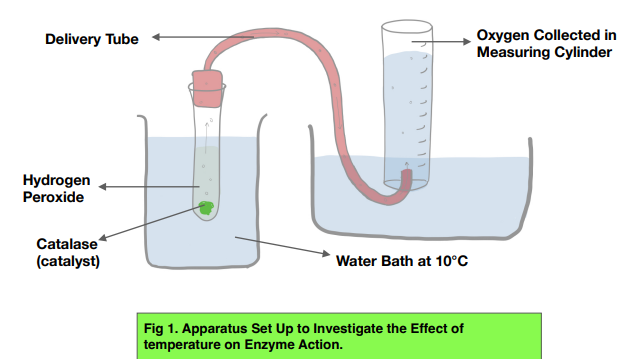
Investigating the Effect of pH
We can explore the effect of pH on the rate of reaction of the enzyme amylase. Amylase is an enzyme that helps breakdown starch into maltose. You can use iodine solution to test for the presence of starch in this experiment. When starch is present, the iodine solution will undergo a colour change from orange-brown to blue-black.
- Set up a bunsen burner on top of a heat proof mat with a tripod and gauze.
- Place a beaker of water with a thermometer on the gauze and heat the water to 35°C. Try to maintain the temperature at 35°C by adjusting the flame.
- On a spotting tile, in each well, place a drop of iodine solution.
- In a test tube, add 2cm3 amylase solution and 2cm3 starch solution.
- Then add 1cm3 of a pH buffer solution at pH 5. The buffer solution will maintain the pH.
- Place the tube into the beaker of water and start your stopwatch.
- Every 20 seconds, using a pipette, take a sample of the solution and add it to a well on the spotting tile.
- Keep adding the solution to a new well until the iodine stops turning blue-black and note the time it takes to do this. This means that the starch has been broken down.
- Repeat the experiment with different pH buffer solutions. You will see that the time it takes for the iodine to stop changing colour changes with the pH solutions.
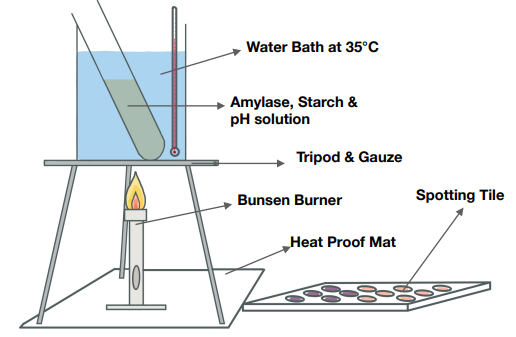

Investigating the Effects of Other Factors
We can explore other factors too:
- Enzyme concentration – change the initial enzyme concentration
- Substrate concentration – change the initial substrate concentration
Calculating Rate of Reactions
We can calculate the rate of reaction of a reaction by looking at either:
- The amount of reactant used up
- The amount of product made.
We use different methods for different reactions. For example, if a reaction produces lots of oxygen gas via bubbles we can count bubbles to measure the amount of oxygen (product) made.
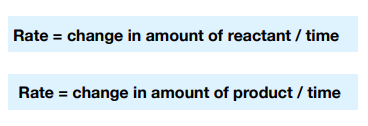
Calculating Rates from Graphs
In exams you will often be given graphs in experiment questions, and may need to calculate the rate of reaction.
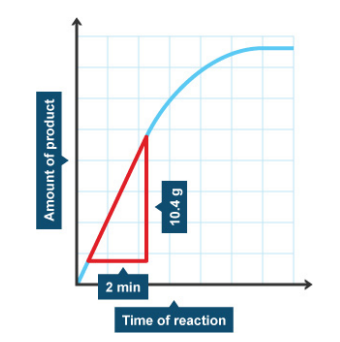

The rate of reaction is just the gradient. The gradient = rise / run. Here is the step by step process:
- Check the graph’s axes. Most graphs, like this one, will show you a product-time graph, with product formation on the y-axis and time of reaction on the x-axis.
- Pick two points on the graph. Pick two points on the graph, and measure the rise (y-axis) and run (x-axis) between the two points. You can count the rise and run using the grid squares. Try to pick two points which give you easy whole numbers for both rise and run.
- Gradient = Rise / Run. Divide the rise by the run to give the gradient. Here it is 10.4 / 2. Pay careful attention to your units – here it is grams per minute.
- Check your gradient. Check that the gradient is constant throughout if your graph is a curve. In this graph, we could say that the rate does decrease as the reaction continues beyond the point we’re looking at.
The final rate for this example is 5.2 g/min.
Example Question
Practice Question: Jessica set up an experiment to measure the rate of reaction between zinc and excess hydrochloric acid. She measured the amount of hydrogen given off in the reaction. Calculate the rate of reaction between 0-20 seconds and between 20-50 seconds. Why does the rate change?
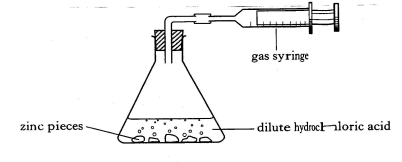
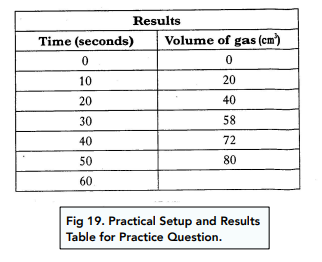
- Calculate the rate between 0-20 seconds

Rate = (40-0) / 20 = 2 cm3/s - Calculate the rate between 20-50 seconds

Rate = (80-40) / 30 = 1.33 cm3/s - Why does the rate change?
Over the course of a reaction, the reactant particles will get used up, so the rate of reaction will fall. Here, we are told that the acid is in excess, so it must be the zinc which is used up, explaining the fall in the rate.
Enzymes are proteins that are involved in catalyzing chemical reactions in living organisms. They speed up reactions by reducing the amount of energy required to reach the activation energy.
Enzymes play a crucial role in the digestive system, by breaking down complex molecules like carbohydrates, proteins, and fats into simpler molecules that can be absorbed and used by the body. For example, the enzyme amylase breaks down carbohydrates into simpler sugars, while proteases break down proteins into amino acids.
Temperature can have a significant effect on the rate of enzyme-catalyzed reactions. Generally, increasing temperature will increase the rate of reaction, as the increased thermal energy makes it easier for reactant molecules to collide and form the activated complex. However, if the temperature is too high, the enzymes can become denatured, or lose their shape, and become inactive.
The pH of a solution can also have an impact on the rate of enzyme-catalyzed reactions. Enzymes have an optimal pH range, within which they function best. If the pH deviates from this range, the enzymes can become denatured and lose their activity.
The concentration of substrate molecules in a solution can also affect the rate of enzyme-catalyzed reactions. As the substrate concentration increases, the rate of reaction will also increase, until the enzymes become saturated and the reaction rate reaches a maximum. Beyond this point, increasing substrate concentration will not have a significant effect on the reaction rate.
Understanding the factors that can affect enzyme action is important in many areas of biology and medicine, including the study of digestive processes and the design of drugs that target specific enzymes. It is also a key part of GCSE biology studies, as students learn about the role of enzymes in biological processes and the factors that can influence their activity.






Still got a question? Leave a comment
Leave a comment